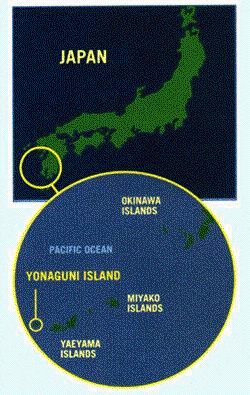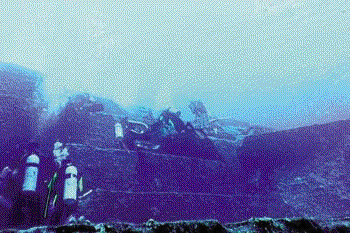|
|
|
 Although the Japanese underwater structures have been reported on
extensively in the Japanese popular press, there have been only a few
English-language reports concerning these ancient underwater sites (Barot, 1998;
Joseph, 1997). The structures that have been discovered thus far are all located
off the coasts of Okinawa and various islands of the Ryukyu Island chain, Japan
(Joseph, 1997). The best publicised and most spectacular of these structures
the Monument is located off the southern coast of Yonaguni Island
(see location map in Minamiyama, 1997, p19). Yonaguni is a small (approximately
10 km by 4 km [6.25 miles by 2.5 miles]) Japanese island located east of Taiwan
and west of Ishigaki and Iriomote Islands in the East China Sea. Dr. Masaaki
Kimura has carried out an extensive underwater mapping project of the Yonaguni
Monument (Anonymous, 1995, 1996, 1997; Border Land magazine and TBS BROADCASTER
TV Show, 1997; Lee, 1997; Minamiyama, 1997; Yamaguchi, 1997).
Although the Japanese underwater structures have been reported on
extensively in the Japanese popular press, there have been only a few
English-language reports concerning these ancient underwater sites (Barot, 1998;
Joseph, 1997). The structures that have been discovered thus far are all located
off the coasts of Okinawa and various islands of the Ryukyu Island chain, Japan
(Joseph, 1997). The best publicised and most spectacular of these structures
the Monument is located off the southern coast of Yonaguni Island
(see location map in Minamiyama, 1997, p19). Yonaguni is a small (approximately
10 km by 4 km [6.25 miles by 2.5 miles]) Japanese island located east of Taiwan
and west of Ishigaki and Iriomote Islands in the East China Sea. Dr. Masaaki
Kimura has carried out an extensive underwater mapping project of the Yonaguni
Monument (Anonymous, 1995, 1996, 1997; Border Land magazine and TBS BROADCASTER
TV Show, 1997; Lee, 1997; Minamiyama, 1997; Yamaguchi, 1997).
The structure itself which I call the 'Yonaguni Monument' - has the general appearance of a pyramid with steps or platforms. It has been likened to various pyramidal and temple structures in the Americas, such as the ancient 'Temple of the Sun' near Trujillo in northern Peru (Joseph, 1997, pp4-5). The Yonaguni Monument is over 50 meters (160 feet) long in an east-west direction and over 20 meters (65 feet) wide in a north-south direction. The top of the structure lies about 5 meters (16 feet) below sea level, whereas the base is approximately 25 meters (80 feet) below the surface. Its structure is asymmetrical with what appear to be titanic stone steps exposed on its southern face. These steps range from less than half a meter (a foot and a half) to several meters (many feet) in height (see Figures 1 through 4).
 The Yonaguni
Monument is composed predominantly of medium to very fine sandstones and
mudstones of the Lower Miocene Yaeyama Group (Kimura, 1997. See also the
geologic map of Yonaguni Island in Minamiyama, 1997, p41, and the general
discussion of the stratigraphy of the area in Minato et al., 1965, p271, and
Takai et al., 1963). WHAT IF IT WAS
MAN-MADE? "If it is confirmed that the site is as old as 10,000 years and is
man-made, then it is going to change an awful lot of the previous thinking on
south-east Asian history." Jim Mower, archaeologist, University College London
(cited in Barot 1998). "I hope this site is artificial as it would be very
exciting but I feel it is too early to say." Teruaki Ishii, professor of
geology, Tokyo University (cited in Barot 1998). "The structure could be an
ancient shrine, possibly celebrating an ancient deity resembling the god
Nirai-Kannai, whom the locals say gave happiness to the people of Okinawa from
beyond the sea.
The Yonaguni
Monument is composed predominantly of medium to very fine sandstones and
mudstones of the Lower Miocene Yaeyama Group (Kimura, 1997. See also the
geologic map of Yonaguni Island in Minamiyama, 1997, p41, and the general
discussion of the stratigraphy of the area in Minato et al., 1965, p271, and
Takai et al., 1963). WHAT IF IT WAS
MAN-MADE? "If it is confirmed that the site is as old as 10,000 years and is
man-made, then it is going to change an awful lot of the previous thinking on
south-east Asian history." Jim Mower, archaeologist, University College London
(cited in Barot 1998). "I hope this site is artificial as it would be very
exciting but I feel it is too early to say." Teruaki Ishii, professor of
geology, Tokyo University (cited in Barot 1998). "The structure could be an
ancient shrine, possibly celebrating an ancient deity resembling the god
Nirai-Kannai, whom the locals say gave happiness to the people of Okinawa from
beyond the sea.
Masaaki Kimura, professor of geology, University of the Ryukyus, Okinawa (cited in Barot 1998). Read Robert Schoch's investigation of the structure in Fortean Times 114. OUT NOW